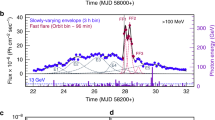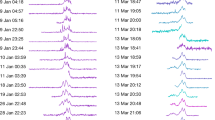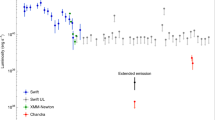Abstract
LARGE fluctuations in the radio emissions from the quasar 0954 + 658 (ref. 1) attest to the existence of large-scale inhomogeneities in the ionized interstellar medium. These fluctuations, termed extreme scattering events, are caused by the refractive focusing of the radio waves by discrete plasma structures. In principle, the radio emissions of pulsars should also be a sensitive probe of such phenomena2–5, which should be manifest as fluctuations in the flux density and increased delays in the timing measurements. Here we report the detection of an extreme scattering event, lasting about 15 days, in timing observations of the millisecond pulsar 1937 + 21. This event provides independent evidence for the existence of large-scale structure in the interstellar medium, and allows us to constrain the properties of the lensing structure (distance, velocity, linear dimension and electron density) more tightly than has been possible from detections of lensed extragalactic radio sources. Of more practical importance, such events could be the dominant source of timing noise in millisecond pulsars at ∼1 GHz, and will need to be considered when searching for the subtle signature of gravitational waves in pulsar timing measurements.
This is a preview of subscription content, access via your institution
Access options
Subscribe to this journal
Receive 51 print issues and online access
$199.00 per year
only $3.90 per issue
Buy this article
- Purchase on Springer Link
- Instant access to full article PDF
Prices may be subject to local taxes which are calculated during checkout
Similar content being viewed by others
References
Fiedler, R. L., Dennison, B., Johnston, K. J. & Hewish, A. Nature 326, 675–678 (1987).
Romani, R. W., Blandford, R. D. & Cordes, J. M. Nature 328, 324–326 (1987).
Goodman, J. J., Romani, R. W., Blandford, R. D. & Narayan, R. Mon. Not. R. astr. Soc. 229, 73–102 (1987).
Cordes, J. M., Pidwerbetsky, A. & Lovelace, R. V. E. Astrophys. J. 310, 737–767 (1986).
Foster, R. S. & Cordes, J. M. Astrophys. J. 364, 123–135 (1991).
Hellings, R. W. Astr. J. 91, 650–659 (1986).
Taylor, J. H. & Weisberg, J. M. Astrophys. J. 345, 434–450 (1989).
Lyne, A. G. & Thorne, D. J. Mon. Not. R. astr. Soc. 172, 97–108 (1975).
Taylor, J. H. & Cordes, J. M. Astrophys. J. 411, 674–684 (1993).
Bochkarev, N. G. & Sitnik, T. G. Astrophys. Space Sci. 108, 237–302 (1985).
Hester, J. J. Astrophys. J. 314, 187–202 (1987).
Dennison, B. & Simonetti, J. H. in Colloquium on Subarcsecond Radio Astronomy Manchester, 20–24 July 1992 (eds Davis, R. J. & Booth, R. S.) 92–93 (Cambridge Univ. Press, 1993).
Author information
Authors and Affiliations
Rights and permissions
About this article
Cite this article
Cognard, I., Bourgois, G., Lestrade, JF. et al. An extreme scattering event in the direction of the millisecond pulsar 1937 + 21. Nature 366, 320–322 (1993). https://doi.org/10.1038/366320a0
Received:
Accepted:
Issue Date:
DOI: https://doi.org/10.1038/366320a0
Comments
By submitting a comment you agree to abide by our Terms and Community Guidelines. If you find something abusive or that does not comply with our terms or guidelines please flag it as inappropriate.



